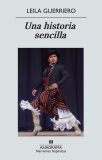New Spanish Books: The online guide of titles from Spanish publishers and literary agents with rights for translation in the UK. To consult titles available in other markets please click on the above links.
Una historia sencilla

In January 2011, Leila Guerriero travelled to a small town in the interior of Argentina to tell the story of a dance competition: the Laborde National Malambo Festival. The malambo is a traditional dance of the Argentinian gauchos and the festival ends with the crowning of a champion. In order to maintain the prestige of the contest, the champions have made a pact to never again enter the competition after winning. On the second night of the festival, Guerriero saw a stunning dancer, Rodolfo González Alcántara, and decided to tell his story. The result is this chronicle, brimming with suspense and packed with charming characters, in which González Alcántara takes on the dimensions of a tragic gladiator. This book recounts the most difficult of epics: the epic of the common man.
“Una historia sencilla” is the only work of non-fiction chosen by the panel, a piece of passionate reportage about the little known world of “Malambo”.
Malambo is the traditional dance of the gauchos, legendary cattle herders of the Argentinian Pampas region. Like this solitary figure, the malambo dancer is expected to project an aura of fortitude, long-suffering, honour and virtue. One routine of malambo for male adult dancers consists of almost five minutes of high-speed movement, otherworldly corporeal tension and utmost concentration. For nearly fifty years, in a small town five hundred kilometers from Buenos Aires, called Laborde, a festival has been celebrated in honour of this dance (…)
In order to compete at Laborde, dancers commit to elite-level athletic training throughout the year, paying copious amounts of money for transport, classes and costumes. Most of them come from relatively poor backgrounds. For all of them, the title of champion at Laborde is the ultimate success as well as the greatest sacrifice; once you have won you are not allowed to compete anywhere else, in short, you retire as a competitive dancer. Continuing as a teacher to future talents, you help maintain the image of Laborde as the peak of any malambo dancer’s life. (…)
Guerriero’s book may take the outward form of reportage, but it is also a biography, a series of vignettes, and a well-focused story with an intriguing plot - the reader cannot help but want to know if Alcántara’s efforts will pay off in the end. The competition as a framing event gives every chapter a dramatic underlining. To describe dancing in written form is difficult enough with styles which are more widely known. As tools, Guerriero uses an array of imaginative similes. Her descriptions of dance are full of the animal, the raw, and the emotional. Most of all, she uses her own reactions as an outsider to transfer the experience of dance to the reader. I wouldn’t imagine that it’s possible for any text to give you an accurate impression of what the dance looks like, but it does awaken an interest and curiosity, both for the subject and her particular story. As for myself, it did send me searching for videos of malambo. (…)
As a journalist, she clearly conveys her position as uninitiated, as well as her deep fascination with the subject, without falling into self-absorption and prolonged inner reflections. The story stays with its main characters, and thus remains interesting. (…) (From the report by Jessica Johannesson Gaitán)
